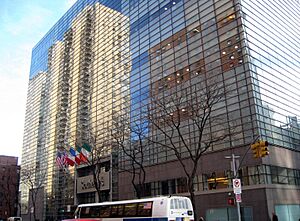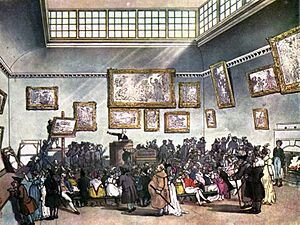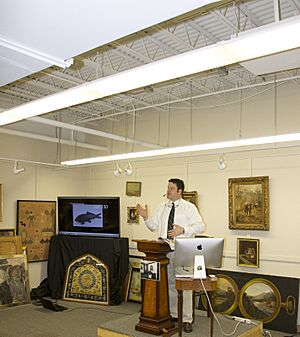Art auction facts for kids


An art auction is a special event where artworks are sold to the highest bidder. It's like a competition where people offer money for a piece of art, and the person who offers the most gets to buy it. These sales usually happen in special places called auction houses.
In England, art auctions started way back in the late 1600s. People would often keep the names of the auctioneers a secret back then. Before an auction, a special book called an auction catalog is made. This book lists all the art pieces that will be sold.
Some of the most famous auction houses today are Christie's and Sotheby's. But the oldest one is the Stockholm Auction House in Sweden, which opened in 1674!
Contents
History of Art Auctions
How Art Auctions Started
Before auctions became common, people would just put a price on each artwork and wait for someone to buy it. This was a very slow way to sell large collections, especially for paintings. It also didn't have the excitement of an auction.
The first really big art collection sold this way belonged to Edward, Earl of Oxford, in 1742. Many important people, like Horace Walpole, came to this sale. Prices for art varied a lot, from small amounts for simple paintings to much higher prices for famous works like one by Anthony van Dyck.
Another huge sale was Dr. Richard Mead's collection in 1754. It brought in more money than any art sale before it. Later, the Duchess of Portland's collection was sold in 1786. This sale included the famous Portland vase, which you can now see in the British Museum.

By the end of the 1700s, many artworks were being brought into England. This was partly because England was seen as a safe place for valuable items during political problems in other parts of Europe. This also helped people in England learn more about art. Famous works started selling for very high prices. For example, a small painting by Leonardo da Vinci sold for 1,300 guineas (an old British coin) in 1801. Later, two paintings by Rembrandt each sold for 5,000 guineas.
New Collectors and Changing Tastes
In the mid-1800s, a new kind of art collector appeared. These were often people who had become rich from new industries in England. They bought art directly from artists or from art shows. They weren't always interested in old traditions.
Sometimes, these new art purchases turned out to be great investments, selling for much more later. But sometimes, they sold for less than what was originally paid. For example, a painting called Otter Hunt by Edwin Landseer sold for much less than its original price.
During the 1870s, water-colour drawings became very popular and sold for high prices. For instance, J. M. W. Turner's Bamburgh Castle water-colour sold for 3,150 guineas. Another example is David Cox's The Hay-field, which sold for 259 guineas, even though the artist had sold it for only 50 guineas years earlier.
While modern art was popular, some collectors still loved the works of Old Masters. Sales of collections like the Hamilton Palace collection in 1882 were huge events. Many beautiful old paintings found new owners at high prices. For example, two portraits by Anthony van Dyck sold for 17,700 pounds in 1900.
Popular Artists and Rising Prices
From the late 1800s to the early 1900s, paintings by English artists like Joshua Reynolds became very popular, especially portraits of women. This was partly because of art shows that brought these artists back into public view.
Some amazing prices were paid for these paintings:
- Joshua Reynolds's Lady Betty Delmé sold for 11,000 guineas in 1894.
- Thomas Gainsborough's Duchess of Devonshire sold for 10,100 guineas in 1876.
- J. M. W. Turner's Mortlake Terrace sold for 12,600 guineas in 1908.
During this time, art from other European countries, especially France, also became very popular. Works by artists like Jean-Baptiste-Camille Corot and Ernest Meissonier fetched high prices. There was also a strong demand for 18th-century French painters like Watteau and Boucher.
A big change in art collecting during this period was "specialism." This meant collectors started focusing on very specific types of art, like drawings by Old Masters or certain kinds of porcelain. This led to very high quality collections being sold. For example, mezzotint portraits (a type of print) became incredibly valuable. A mezzotint of the Sisters Frankland sold for 290 guineas in 1900, even though it had cost only 10 guineas 30 years before.
In the early 1900s, art prices and competition at auctions grew even more. Buyers from the United States and Germany played a big part in this. By 1911, there were more people wanting the best artworks than there were artworks available.
Modern Art Auctions
In the late 20th century, art prices continued to climb. In 1970, Diego Velázquez’s Portrait of Juan de Pareja sold for $5.5 million. This price was three times higher than any art piece had sold for before. In 1990, Vincent van Gogh’s Portrait of Doctor Gachet sold for an amazing $82.5 million.
In the 21st century, art prices have reached even higher levels. In 2013, a painting by Francis Bacon called Three Studies of Lucian Freud sold for $142.4 million. The highest price ever paid for an artwork at auction was for Pablo Picasso's Les Femmes d'Alger (Version O). It sold for $179.4 million in 2015.
Today, auction houses like Sotheby's and Christie's are also major sellers of Chinese porcelain antiques. Many valuable collections have been sold for tens of millions of US dollars.
Since 2010, it has become more common for artworks to sell for over $100 million. Many of the most expensive paintings ever sold at auction have been bought in recent years. What makes a painting so expensive? It depends on the artist's fame, how old the piece is, the current art market, where the art came from (its provenance), and how long it has been since it was last sold.
A big change in 21st-century art auctions is the rise of online bidding. Now, you can bid on art from anywhere in the world. This has helped big auction houses like Christie's and Sotheby's reach more people. It has also allowed new online-only auction sites to start. This means more art is available to a wider audience, and collectors from places like Asia are becoming very important in the art market.
See also
- Art dealer
- Art valuation
- Blockage discount
- CINOA, an international organization of art dealers


